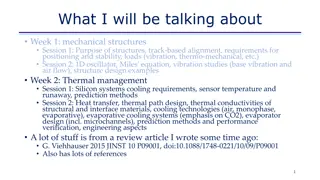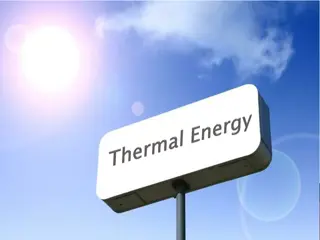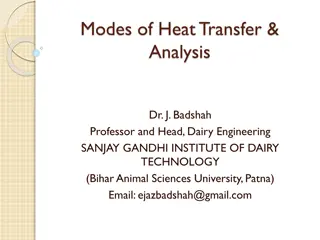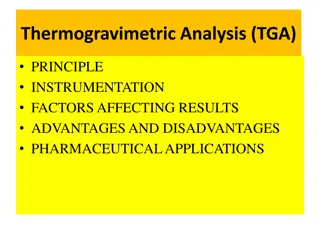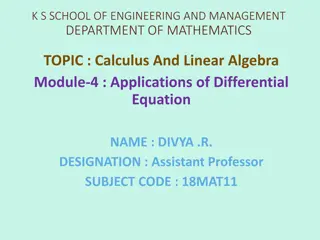Understanding Differential Thermal Analysis (DTA) in Pharmaceutical Applications
Differential Thermal Analysis (DTA) is a technique used in pharmaceutical applications to monitor temperature differences between a sample and reference material. By analyzing temperature changes over time or against temperature, DTA helps in detecting phase transitions and reaction temperatures in pharmaceutical compounds. The instrumentation of DTA involves temperature-controlled furnaces with sensors connected to recording devices for data analysis. This analytical method offers insights into the thermal behavior of pharmaceutical substances, aiding in formulation and quality control processes.
Download Presentation

Please find below an Image/Link to download the presentation.
The content on the website is provided AS IS for your information and personal use only. It may not be sold, licensed, or shared on other websites without obtaining consent from the author. Download presentation by click this link. If you encounter any issues during the download, it is possible that the publisher has removed the file from their server.
E N D
Presentation Transcript
Differential Thermal Analysis DTA PRINCIPLE INSTRUMENTATION ADVANTAGES & DISADVANTAGE PHARMACEUTICAL APPLICATIONS DERIVATIVE DIFFERENTIAL THERMAL ANALYSIS (DDTA)
Differential Thermal Analysis A technique in which the difference in temperature between the sample and a reference material is monitored against time or temperature while the temperature of the sample, in a specified atmosphere, is programmed. The sample and the reference are placed symmetrically in the furnace. The furnace is controlled under a temperature program and the temperature of the sample and the reference are changed. During this process, a differential thermocouple is set up to detect the temperature difference between the sample and the reference. Also, the sample temperature is detected from the thermocouple on the sample side.
Graph (a) : temperature change of the furnace, the reference and the sample against time. Graph (b): change in temperature difference ( T) against time detected with the differential thermocouple. T signal : DTA signal. Matters that do not change in the measurement temperature range (usually -alumina) are used as reference. When the furnace heating begins, the reference and the sample starts heating with a slight delay depending on their respective heat capacity, and eventually heat up in according to the furnace temperature. T changes until a static state is reached after the heating begins, and after achieving stability, reaches a set amount compliant with the difference in heat capacity between the sample and the reference. The signal at the static state is known as the baseline. When the temperature rises and melting occurs in the sample, for example, the temperature rise stops as shown in graph (a) and the T increases. When the melting ends, the temperature curve rapidly reverts to the baseline. At this point, the T signal reaches the peak, as shown in graph (b). From this, we can detect the sample transition temperature and the reaction temperature from the T signal (DTA signal). In graph (b), the temperature difference due to the sample endothermic change is shown as a negative direction and the temperature difference due to the sample exothermic change is shown as a positive direction.
INSTRUMENTATION The basic components of a DTA apparatus are Temperature-controlled furnace containing sample and reference cells A pair of matched temperature sensors connected to recording apparatus The temperature sensors (usually thermocouples) are in contact with the sample and reference or their containers, and the output is amplified and recorded. DTA data may be plotted as a function of sample temperature, reference temperature (as is usually the case), or time. In both DTA and DSC, the measurement relies on the occurrence of a temperature difference between a sample and reference ( T) as a result of the thermal event in question.
INSTRUMENTAION In the case of DTA, an inert material is placed in the reference pan such that the heat capacity of the sample is approximately matched. Under these conditions, when the sample and reference are being heated at a constant rate, the DTA signal will be small when no transition is occurring. Ideally, the arrangement of the pans in the furnace is exactly symmetrical; so when the heat capacity of sample and reference are exactly the same, the temperature difference is zero.
INSTRUMENTATION When the sample melts, the rate of temperature increase for the sample will be lower than that of the reference, as the energy imparted by the heating signal will be contributing to the breaking of solid solid bonds rather than simply the raising of the sample temperature. The heat input into the sample contributes to the melting process rather than the increase in temperature, whereas the heat input into the reference continues to lead to a temperature increase. When melting is complete, the sample returns to the programmed temperature; hence, by examining the difference in temperature between the two pans, a peak is seen, as shown in Figure b
INSTRUMENTATION Composed of five basic components,: (i) Sample holder with built-in thermocouple assembly, (ii) Flow-control system, (iv) Preamplifier and Recorder, and (v) Furnace Power Programmer and Controller. (iii) Furnace assembly,
INSTRUMENTATION (a) Thermocouples employed are normally unsheathed Platinum Vs Platinum and Sodium Vs 10% Rhodium. Two thermocouples measures the difference in temperature between a sample S and an absolutely inert reference substance R, as both are subjected to heating in a ceramic/ metal block inside a furnace being operated by a temperature programmer and controller. (b) The output of the differential thermocouple is amplified adequately through a high gain, low-noise preamplifier and subsequently hooked to the recorder, one axis of which is driven by the block temperature signal and is measured by a third thermocouple.
INSTRUMENTATION (c) Heating/Cooling Device : A sufficient versatility is achieved by the aid of a pressure-vacuum, high-temperature electric furnace. An almost constant heating rate is usually achieved by using a motor-driven variable auto transformer. Both heating rates and cooling rates may be conveniently adjusted continuously : (i) From 0 -30 C/minute by some instruments, and (ii) From a choice of several commonly employed heating rates viz., 2 , 4 , 8 and 16 C/minute. Usual workable sample temperatures are upto : 500 C. Exceptional maximum temperatures are upto : 1000 C. (d) Relatively small sample volumes help in two ways : first, they make evacuation easy ; and secondly, they minimize thermal gradients.
METHODOLOGY Insert a very thin thermocouple into a disposable sample tube, 2 mm in diameter and containing 0.1-10 mg of sample (ii) Another identical tube is either kept empty or filled with reference substance, such as quartz, sand, alumina or alundum powder (iii) The two tubes are simultaneously inserted into the sample block and heated (or cooled) at a uniform predetermined programmed rate, (iv) DTA is a dynamic process so, vital aspects for getting reproducible results are : Pretreatment of the specimen Particle size and packing of the specimen Dilution of the specimen Nature of the inert diluents Crystalline substances must be powdered, and sieved through 100-mesh sieve For colloidal particles (e.g., clays), micelle-size is very critical, and Either to suppress an unwanted reaction (e.g., oxidation), or to explore the study of a reaction (e.g., gaseous reaction product) the atmosphere should be controlled adequately. (i)
Differential thermal analysis investigation of calcium acetate monohydrate at a uniform programmed heating rate of 12 C/minute
The chemical reactions involved in the differentiated thermal analysis of calcium acetate monohydrate may be expressed as follows : Stage I : The endothermal dehydration of calcium acetate monohydrate occurs giving rise to the anhydrous salt. It is easily noticed by an endothermal band on DTA curve between 200 C and 250 C. Stage II : The anhydrous salt undergoes endothermal decomposition reaction at 350-400 C resulting into the formation of CaCO3 It has been observed that this decomposition reaction seems to be almost alike in the presence of either CO2 or Ar. Stage III : The decomposition of calcium carbonate to calcium oxide, which is a function of the partial pressure of the CO2 in contact with the sample. The endothermal band for the carbonate decomposition is sharply peaked spread over a relatively narrower temperature range in an atmosphere of CO2
DERIVATIVE DIFFERENTIAL THERMAL ANALYSIS Amethod for precise determination in thermograms of slight temperature changes by taking the first derivative of the differential thermal analysis curve (thermogram) which plots time versus differential temperature as measured by a differential thermocouple. Also known as DDTA. The temperatures of peaks of bands as well as details often overlooked in DTA curves, such as inflections which appear as peaks in DDTA curves, make this technique useful for characterization of substances as well as for studying reaction kinetics using a duplicate sample as the reference material and maintaining a constant temperature differential in the applied temperatures between both samples. The principle of this technique permits automatic recording of the DDTA curve and is the basis for the derivative thermogravimetric curves
APPLICATIONS The various important applications of DTA are : (i) Rapid identification of the compositions of mixed clays, (ii) Studying the thermal stabilities of inorganic compounds, (iii) Critically examining in a specific reaction whether a new compound is actually formed or the product is nothing but an un-reacted original substance, and (iv) DTA offers a wide spectrum of useful investigations related to reaction kinetics, polymerization, solvent retention, phase-transformations, solid-phase reactions and curing or drying properties of a product.



